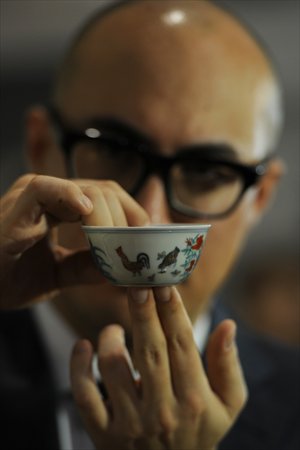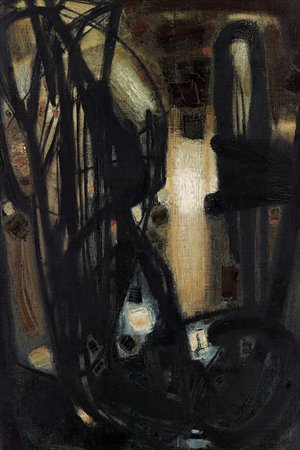Strong signals
By Lu Qianwen Source:Global Times Published: 2014-4-14 20:43:01

A Meiyintang Chenghua "Chicken Cup" is displayed by deputy chairman for Sotheby's Asia Nicolas Chow after it was sold for a record price in Hong Kong on April 8, 2014. Photo: CFP

Painting No.33 by Zhu Dequan Photo: Courtesy of China Guardian
The traditional month for the Chinese mainland's annual Spring Auction, May usually attracts the most powerful local auction houses. Now less than a month before the unveiling of this year's Mainland Spring Auction, expectations are particularly high after the Chinese art market's more than two years of fluctuation.Judging from the performance of the overall global art market as well as the art market in Hong Kong, where several domestic and international heavyweight auctions just concluded, it looks like this is going to be a bumper year.
"The market is heating up, with old buyers returning and new buyers getting involved," said Xie Xiaodong, deputy general manager of the Council International Auction Company. "Some quality pieces are going to be put out as a way to test market waters, it's definitely going to be better than last year," Xie told the Global Times.
Shaking off uncertainty
If 2013 was a year full of uncertainties, this year will surely be a bullish year in many insiders' eyes. According to the latest authoritative figures concerning the 2013 global art market released by The European Fine Art and Antiques Fair in mid March, total sales for the global art and antique market last year reached 47.4 billion euros ($65.8 billion), almost a complete return to pre-global recession levels.
In 2007, the global art market peaked with sales reaching 48 billion euros ($66 billion) in total. However, battered by the economic crisis and the following recession over the next few years, the global art market became stuck in a quagmire. By 2009, it had contracted to only 28.2 billion euros ($39 billion).
The world's No.2 largest art market since 2010, the local market in China has been dancing to the beat of a different drum. 2010 marked the height of the domestic art market, with total auction transaction volume reaching $8.3 billion to take 23 percent of the global share. The Chinese art market surpassed the UK that year, becoming the 2nd largest art market following the US.
However, witnessing two years of strong momentum in 2010-11, the Chinese art market slid sharply in 2012, with sales volume dropping 24 percent. The following year, 2013, has been widely recognized as an adjustment period for the domestic market, despite the slight increase of 2 percent market growth.
Chicken little, big money
The biggest art magnet in Hong Kong each season, Sotheby's Spring Auction has sent the strongest signal this year that the Chinese art market will experience a revival. Last week, during its 4-day-long auction, two Chinese porcelain pieces became the highlights of the auction. The first piece, a chicken cup made during the Ming Dynasty (1368-1644) was bought at the price of HK$281.24 million ($36.05 million) by Liu Yiqian, breaking the record for Chinese porcelains.
"Since the Ming Dynasty, chicken cups from the Chenghua period (1465-78) were greatly favored by different emperors," said Nicolas Chow, deputy chairman for Sotheby's Asia.
Thanks to their royal ancestry and rarity, chicken cups set a record for Chinese porcelains almost every time they appear at auction.
Another porcelain attracting many eyeballs is a Northern Song Dynasty (960-1127) Ding bowl. "This porcelain has been a focus of collectors for many years. It's the first time in 40 years that this bowl has appeared on the auction market," said Chow. Estimated around HK$ 60 million ($7.7 million), the bowl finally was sold at the price of HK$146.8 million ($19 million).
Targeting the massive number of Chinese mainland collectors, auctions in Hong Kong are never short of contemporary Chinese art. Labeled as a barometer for market reception in this category, works by surrealist painter Zhang Xiaogang have always been a bright spot each time they appear at auction. The Bloodline: Big Family No.3, created by Zhang in 1995, was just auctioned for HK$94.20 million ($12 million) at Sotheby's HK, the highest recorded price for the artist's works.
First appearing on the market at Sotheby's HK in 2008, at the time the painting was sold at the price of HK$47.4 million ($6 million). Now this year, only six years after it was collected, the painting was put up for auction again, leading many to speculate if it would sell for more than last time. In the end the final auction price wiped any doubts from people's minds as to the worth of Chinese contemporary art.
"Zhang's works have been viewed as demonstrating the performance of the overall contemporary Chinese art industry over the past 10 years," said Wu Jin, an art critic, adding, "The record price this time will significantly elevate market confidence."
Led by the strong momentum of Zhang's work, several other Chinese artists' works have also shown excellent standing in Hong Kong. At Poly Auction Hong Kong's Spring Auction, held between April 6 and 7, a special auction for the works of 70-year-old Chinese American artist Cui Ruzhuo, who is widely acclaimed for his traditional Chinese paintings, reached a total of HK$340 million ($44 million) for 16 of his paintings.
A crowded spotlight
Sotheby's undoubtedly has been the most high-key player in previous Hong Kong auctions. However, since 2012 more mainland auction companies have joined Hong Kong auctions, and as their proficiency and expertise increased, Sotheby's no longer was the single limelight during auction week.
Last year, total sales volume for Poly Auction reached HK$1.63 billion ($200 million) in the Hong Kong market, accounting for 21 percent of Poly's total auction revenue for the year.
This year, the Poly Auction HK made HK$1.1 billion ($142 million) in total sales during its Spring Auction alone.
Although another leading player, China Guardian, may not possess as eye-opening a catalogue as Sotheby's, it did very well for itself during its 3-day-long auction in Hong Kong ending on April 9. Twenty-seven of the 30 pieces of contemporary Chinese art were sold at its special auction, with works by the recently deceased Zhu Dequn and Pan Yuliang (1895-1977) a major focus.
"The Hong Kong market is important for mainland auction companies to expand their auction categories into areas in which they were once at a disadvantage, such as jewelry, and earn more collectors," said Xie.
Also considering bringing his auction house into the Hong Kong market in the future, Xie emphasized that domestic auction houses can still compete with international players by optimizing their strengths: ancient and contemporary Chinese paintings.
Posted in: Art